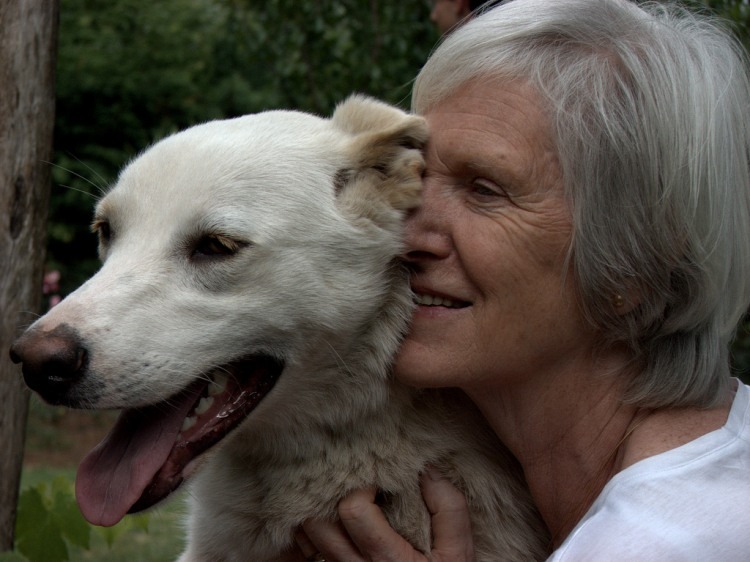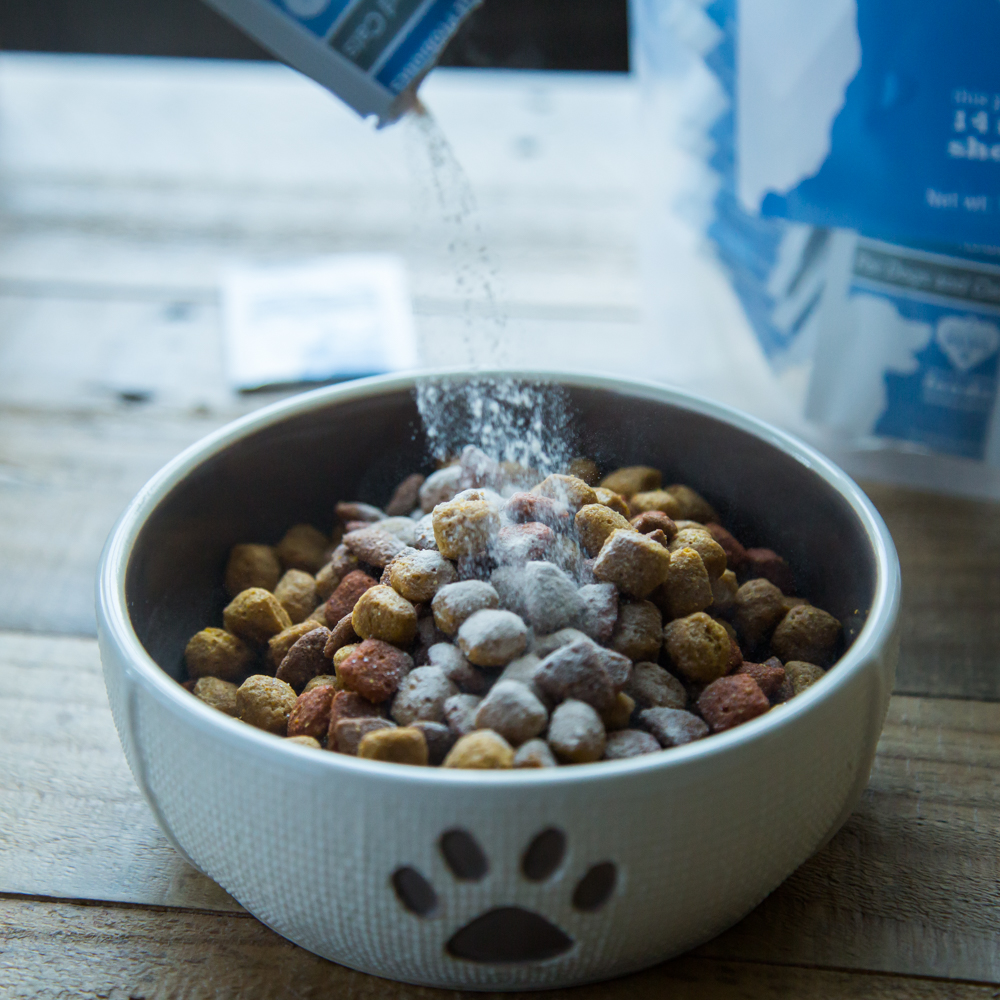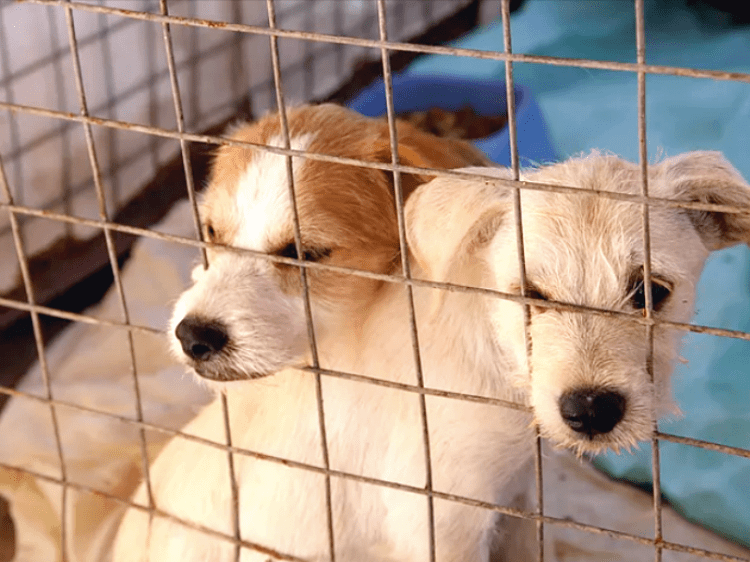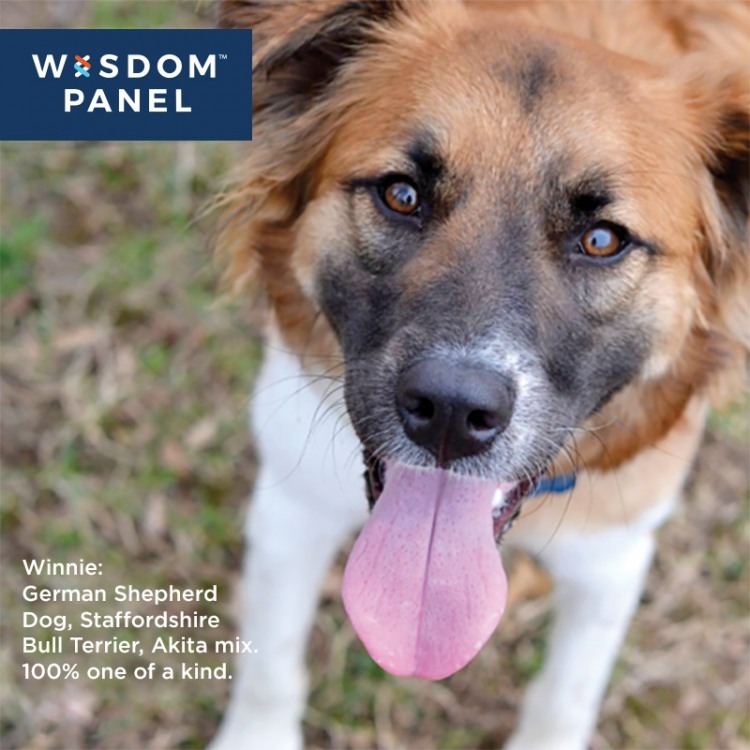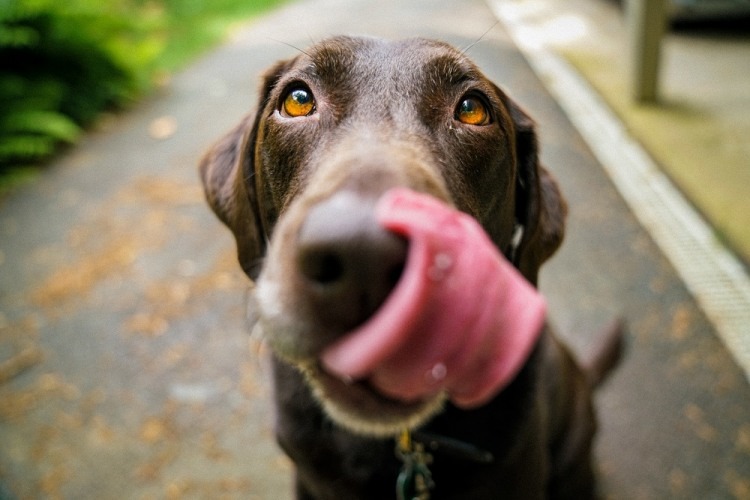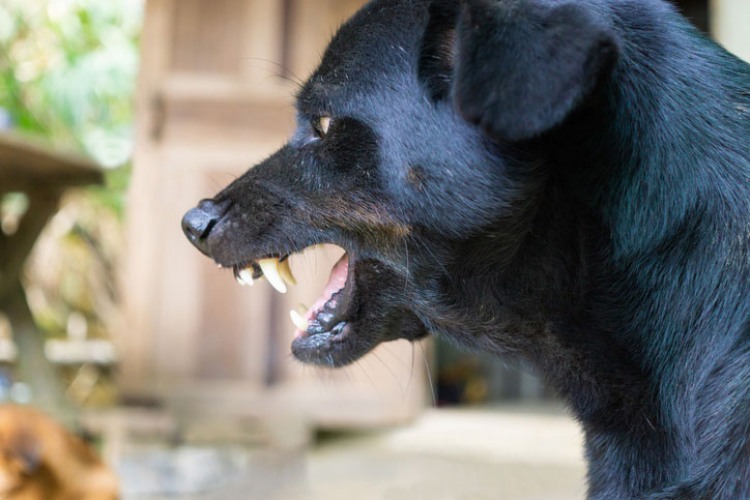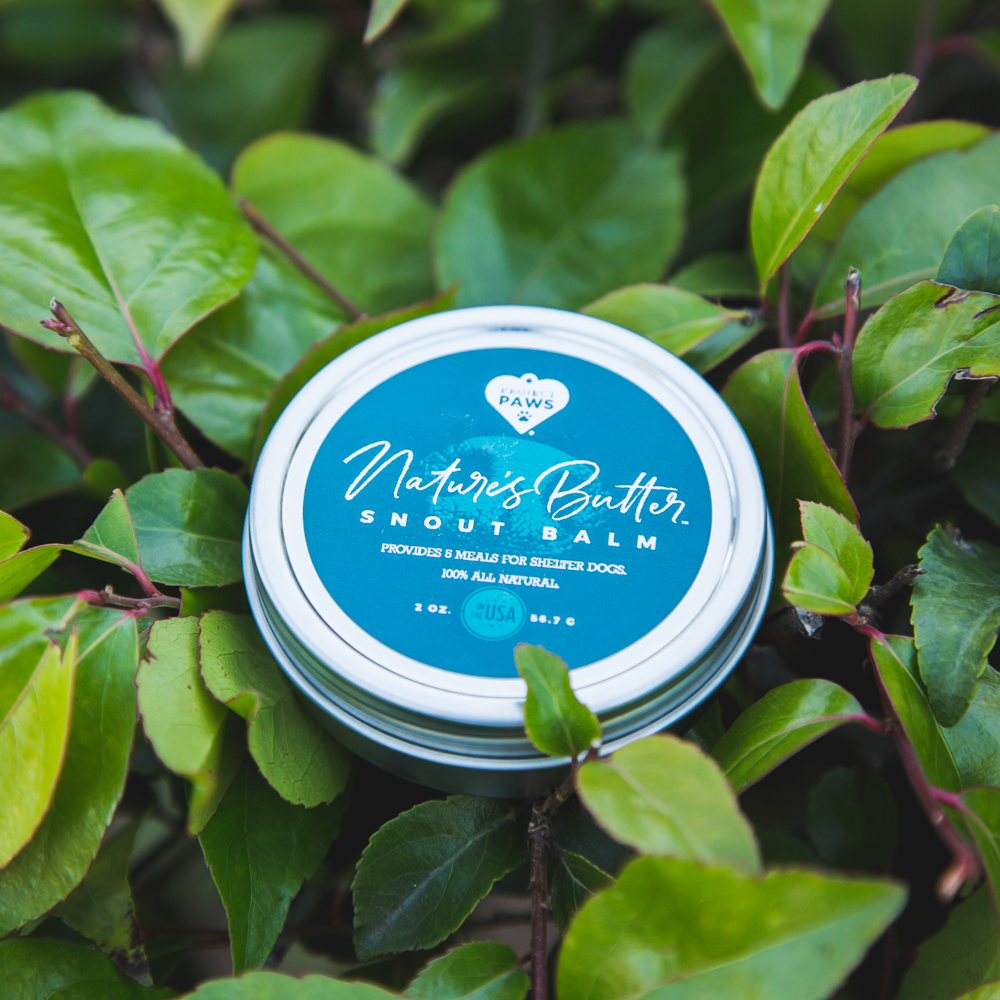About Us
Blog Archive
-
▼
2018
(1554)
-
▼
May
(125)
- 5 Reasons To Talk To Your Dog On A Daily Basis
- 10 Things We Should Do For Our Dogs Because They C...
- Dog Abandoned & Written On With Permanent Marker F...
- Dog Burials In Ancient Times
- The Cure For Your Dog’s Horrific Farts Might Be Su...
- Two Countries Partner to Help Stray Dogs
- DNA Testing Offers a Glimpse of Your Dog’s Past an...
- Dog Rescuer Dies Unexpectedly, Leaving Her 25 Seni...
- Uncovering The Mystery Of How Some Lost Dogs Find ...
- Your Purchases Support Dogs Like Russell, A Former...
- This Deserving Veteran Was Paired With His “Best B...
- New State Bill Seeks To Ban Surgical Debarking
- Everyone's Invited to a Free, Live-Streaming, Dog ...
- With The Help Of 20 Strangers, This Hitchhiking Ho...
- Senior Dog Who’s Called A “Burden” Escapes Euthana...
- NCIS Dog Bite Incident
- 9-Year-Old Boy Takes A Picture With Every Dog He Pets
- Can Dogs “Fake” Illnesses & Injuries For Attention?
- Dry Nose Is A Common Issue With Many Boston Terrie...
- Dry Nose Is A Common Issue With Many French Bulldo...
- Dry Nose Is A Common Issue With Many Boxers, Here’...
- Dry Nose Is A Common Issue With Many Pugs, Here’s ...
- Deterring Loose Dogs
- This Terminally Ill Pup Is Looking For A Family To...
- These 12 Dog Breeds Are The Worst Swimmers
- These 12 Dog Breeds Are The Worst Swimmers
- 6 Possible Reasons Why Your Dog Hates Their Harness
- Senior Pooch Becomes Foster Dad To 9 Orphaned Duck...
- Four Tips to Keep Dogs Safe This Summer
- 8 Strongest Dog Breeds
- California Police Dog Makes Huge Drug Bust First D...
- Meghan Markle Loves Dogs
- Protect Your Dog From Heatstroke & Hyperthermia
- Dog-Walking Etiquette
- 10 Best Dog-Friendly Beaches In The U.S.
- The 10 Least Obedient Dog Breeds
- Soldier Finally Reunites With The Dog She Rescued ...
- Age of Optimal Puppy Cuteness
- How To Protect & Soothe Your Flat-Faced Dog’s Sens...
- Is Coconut Oil Good For Your Dog’s Digestion?
- Red Roof Inn: Where Your Dog Stays–For Free!
- Lost Dogs and Their Finders
- Animal Abuser Slapped With 15 Year Prison Sentence...
- 3 Best Ideas In Animal Welfare Will Compete In The...
- The Humane Society Releases Annual “Horrible Hundr...
- Dog Lacks Herding Experience
- The Brodie Fund
- 10 Best Essential Oils For Your Dog
- Former NFL Player Travels The US With Newly Adopte...
- Teach Your Dog Recall with a Whistle
- Recipes: Seeded Dog Biscuits
- Super Seeds to Add to Your Dog's Diet
- 13 Healthiest “People Foods” For Dogs
- 10 Dog Breeds Known For Hip Problems And How To He...
- Is Your Dog Suffering From Elbow Calluses? Here’s ...
- “Gender Reveal” Puppy Photoshoot Is Almost Too Cut...
- Celebrities & Advocates Watch Shelter Pets Strut T...
- 59 Genes May Make Your Dog a Better Athlete
- A Golden Retriever Makes a Remarkable Recovery
- What You Should Know About Common Thyroid Problems...
- 10 Signs A Puppy Is From A Puppy Mill
- 10 Signs A Puppy Is From A Puppy Mill
- People Know Not To Pet Service Dogs
- Stray Dog Hit By Car Gets The Love He Needs, Thank...
- Dog Displaced By Hurricane Harvey Gets Flown To Hi...
- What Parents Of Short-Muzzled Pups Need To Know Ab...
- Is Your Dog Suffering from a Hot Spot? This $13 Am...
- 12 Tips For Helping Your Dog Live A Longer, Health...
- City Passes Anti-Puppy Mill Law, But One Notorious...
- Teaching an Aggressive Dog to Socialize
- Let's Go For a Walk
- Artful Selfies with Dogs
- The Perfect Last Minute Gift For Dog-Loving Moms!
- Bucket List Buddies Are Making Their Last Days On ...
- 6 Signs Your Dog Would Benefit From A Daily Joint ...
- Dry Nose Is A Common Issue With Many Bulldogs, Her...
- Opioid epidemic affects police dogs too
- Find It: A Dog’s Favorite Mission
- Amazon Employee Helps Customer Whose Puppy Was Sto...
- Woman Inspired By Pup Gives Her Home Spots
- Dislocated And Disabled, These Lava Dogs In Hawaii...
- Proper Dog-to-Dog Introductions: a Step-by-Step Guide
- United’s New Dog Travel Restrictions
- A Hearing Assistance Dog Opens Many Doors for His ...
- Ask A Vet: Why Does My Dog Sniff People’s Privates?
- Family Of Dog With Cancer Searches For Sibling For...
- How To Spot – And Treat – Heat Stroke In Your Dog
- Need A Cuddle Buddy? You Can “Rent-A-Dog” At This ...
- 11 Smallest Dog Breeds
- How gender and stereotypes can shape our relations...
- Public or Private: The fight over NYC’s Warren Str...
- 5 Ways To Manage “Poop Butt” In Long-Haired Dogs
- 5 Ways To Manage “Poop Butt” In Long-Haired Dogs
- How To Help Your Rescue Dog Feel Safe On Walks
- 7 Tips For Choosing The Best Pet-Safe Essential Oils
- The Ultimate Guide For Planning A Summer Road Trip...
- Amazon Breaks Into The Pet Industry With The Launc...
- “Vicious Dog” Actually Loving and Friendly
- Photo Of Death Row Dog’s Freedom Ride Melts Hearts...
- Is Your Dog Reverse Potty Trained?
-
▼
May
(125)
Translate
Breaking News
May 2018
Dog Abandoned & Written On With Permanent Marker Finally Has Hope For A Better Life
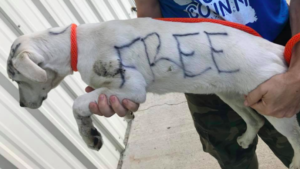
Just when we think we’ve seen it all, another unbelievable rescue story emerges.
Marvella is a pup who was found dumped in a park in Ohio. Although her former owners supposedly wanted her to go to a good home, their actions spoke otherwise.
The message was written on the young white dog in black permanent marker. Across her side it said “FREE,” and on her forehead, “GOOD HOME ONLY.”
Her other side, in very sloppy writing, appears to read, “I AM A GIFT FROM GOD.”
…so why was she drawn on and abandoned?
Luckily, the rest of Marvella’s story is much happier! She’s currently at the Ross County Humane Society in Chillicothe, Ohio, where she was given a bath, “and spent the day in the office with the shelter staff getting lots of treats and attention,” according to the humane society’s Facebook page.
Unsurprisingly, this sweet girl’s story went viral, and the rescue has already been flooded with applications! Without a doubt, Marvella will find her real forever home — one that keeps that beautiful coat clean and treasures her as the gift she really is.
If Marvella’s story touched your heart, you can donate to the Ross County Humane Society or adopt a pup from your local shelter who has a story of their own!
(h/t: 10TV)
via Whisker Therapy
Dog Burials In Ancient Times
A form of simple dog burials began in the Levant region (now Jordan, Israel, Lebanon and Syria) during the sixth century B.C.E. and continued for over six centuries. These purposeful burials have been found in more than a dozen sites, including one that has over 1000 dogs. Previous consideration of these canine burials had led to the conclusion that they were evidence of rituals related to various cults, including the healing cults and or that they symbolized the sacred status of dogs. A recent analysis proposes a new interpretation of these burials.
via Whisker Therapy
The Cure For Your Dog’s Horrific Farts Might Be Surprisingly Simple

Is your dog exceptionally gassy? Do his farts make you gag and want to run from the room? While gas is normal in all animals, at some point it becomes more than just a nuisance and you start to wonder if there’s something wrong with your dog’s digestion. After all, it is the process of digestion that causes gas. Is there anything that can be done to help cure those horrific farts? The answer is yes, and it might be something you take yourself.
The answer is probiotics.
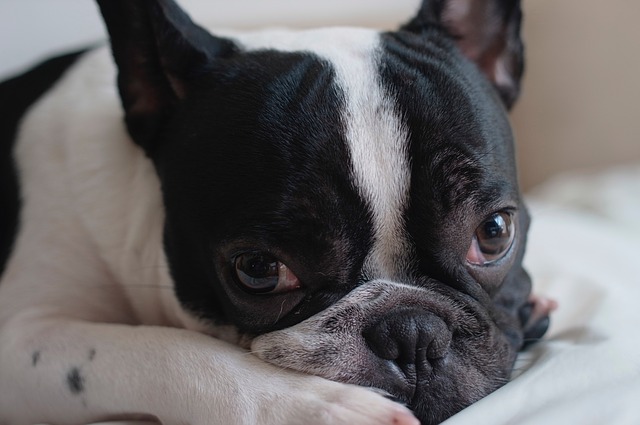
According to the AKC:
“The term [probiotic] refers to beneficial or ‘friendly’ gut-dwelling microbes (bacteria and yeasts). There are billions of them in the gastrointestinal system of all animals, and they aid in the digestion of food, fight off potential pathogens, make nutrients and vitamins, and bolster the immune system.”
If you’ve ever taken antibiotics, you’ve probably been recommended to take a probiotic to help replenish the good bacteria in your gut since antibiotics kill all bacteria, not just the bad ones. You’ve also probably seen commercials advertising yogurt that claims to contain helpful bacteria to aid in digestion. New research is showing that dogs can benefit from probiotics just as much as people can. According to PetMD:
“In a peer-reviewed journal, Marcella D. Ridgway, VMD, MS, DACVIM notes that there is growing evidence that supports the use of probiotics for dogs. She states that giving your dog healthy bacteria may positively impact chronic GI abnormalities, obesity, liver disease, and mood and behavior disorders. A daily probiotic supplement may also provide some ancillary benefits for dogs such as better skin and coat appearance, a reduction in gas, improved breath, a reduction of allergy symptoms, a reduction in yeast-associated disorders, and help in regulating bowel function.”
RELATED: Which probiotic product does iHeartDogs Recommend?
Since probiotics aid in digestion, they can also help dogs who are prone to diarrhea. If your dog is especially prone to stress-related digestive problems, a probiotic can help reduce the likelihood of symptoms and clear up diarrhea faster than doing nothing and may reduce the need for an antibiotic.

Not all strains of probiotics are created equal. The following strains have been shown to be beneficial and safe for dogs:
– Enterococcus faecium
– Lactobacillus acidophilus
– Lactobacillus casei
– Lactobacillus plantarum
– Bifidobacterium bifidum
– Bifidobacterium animalis
– VSL#3
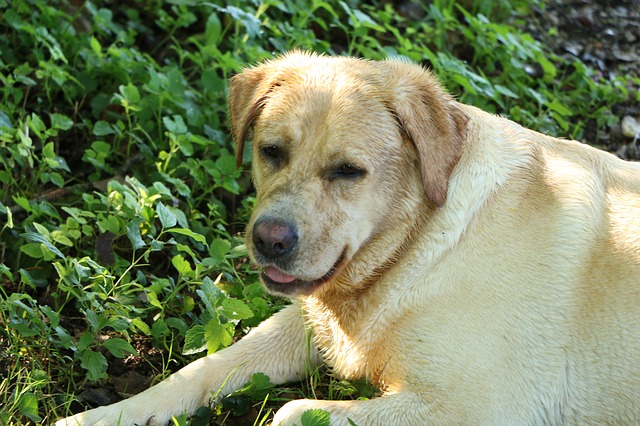
So how should you go about adding probiotics to your dog’s diet? Luckily there are several foods that include probiotics naturally. According to The Bark:
“Yogurt, kefir, onions, bananas, garlic, honey, leeks, kimchi and Jerusalem artichokes all appear regularly on lists of probiotic foods. Some of these items are not ideal for dogs; for example, onions and large quantities of garlic are dangerous and should be avoided. Kimchi is too spicy. The jury is out on dairy products, yogurt included. Some literature contends that dairy causes digestive upset in dogs, but a better part of the homefeeding community includes yogurt in their dogs’ diets to great effect.”
Green tripe is also a highly-recommended food for your dog as it has many health benefits and is easily digested.
RELATED: 6 Things To Consider Before Purchasing a Probiotic for Your Dog
If you want to be certain just how many and which strains of probiotics that your dog is receiving, you might prefer to go with a probiotic supplement instead of relying entirely on food. There are plenty to choose from on the market today. And while it may be OK to share the probiotics you take with your dog, it’s generally considered safer to give your dog a probiotic that’s formulated specifically for dogs.

What should you know if you choose a probiotic supplement instead of trying to include enough probiotics through food alone? According to Whole Dog Journal:
“Many products, particularly those that are not refrigerated, contain fewer live organisms than their labels claim. Freeze-dried probiotics may last longer than refrigerated or other powdered products, especially if the powder is exposed to moisture (such as when the container is opened and closed). Probiotics in commercial foods may not survive processing or storage. Probiotic products should always provide an expiration date.”
Not only will your dog thank you for aiding his digestion and improving the quality of his life with a probiotic, but his stinky farts should resolve, which improves your quality of life also!
Learn More About the Probiotic Formula Recommended by iHeartDogs
These statements have not been evaluated by the Food and Drug Administration. This product is not intended to diagnose, treat, cure, or prevent any disease. The information on this website is not intended to replace a one-on-one relationship with a qualified health care professional.
(H/T: PetMD, AKC, The Bark, Whole Dog Journal)
via Whisker Therapy
Two Countries Partner to Help Stray Dogs
Since 2011, SOAR—Segunda Chansa (“Second Chance”) Oregon Animal Rescue—has been partnering shelters in Loreto, Baja California Sur, Mexico, with shelters in Portland, Oregon, to expand adoption opportunities for abandoned dogs in the Loreto area.
To date, they have sent 248 dogs from Loreto to Portland, where they have all been successfully adopted.
Their partners in Loreto are Segunda Chansa, a private dog rescue and Animalandia, a spay and neuter clinic.
via Whisker Therapy
DNA Testing Offers a Glimpse of Your Dog’s Past and Future
Recent studies show that mixed-breed dogs represent a little over half of all dogs who share our homes in the U.S. This number far outpaces any other single breed, thus it’s fair to say that the mixed-breed dog is America’s most popular canine pet. Guardians of mixed-breed dogs have long had to hypothesize their dog’s ancestry, but today can rely on science to unfold a dog’s genetic profile.
via Whisker Therapy
Everyone's Invited to a Free, Live-Streaming, Dog Conference #SPARCS18
Much of science plays out behind closed doors, and that is exactly what SPARCS is fighting against.
SPARCS, which is short for the Society for the Promotion of Applied Research in Canine Science, is a non-profit bridging the gap between dog lovers and canine science. Started in 2013, it achieves its mission in a straight-forward way: Get a bunch of animal behavior & cognition scientists, geneticists, and veterinarians in a room, have them discuss significant dog science topics, and live stream the three-day conference free on the Internet. If SPARCS is new to you, it's time to join the club. The live streaming conference received over 40,000 hits in past years.
via Whisker Therapy
With The Help Of 20 Strangers, This Hitchhiking Hound Trekked 2,000 Miles To Get Back Home
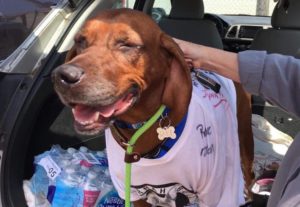
It was just another day walking his dogs in Roaring Spring, Pennsylvania when Adam Herbaugh spotted a lonely Coonhound wandering along his route. He took the hound to a veterinarian where his chip was scanned, and an incredible discovery was made. Although he was in good health, this pup was long way from home — 2,000 miles to be exact — and the story of how he returned from Pennsylvania to Arizona is making headlines!
Once Jake’s microchip was scanned and his identity revealed, his family was contacted to pick him up. But his dog mom, having just had a baby, was unable to undertake the journey… a major bump in the road! But Pennsylvania dog rescue A Darrah Bull Bully Rescue managed to get Jake back where he belongs, not the easiest feat, considering the distance! Luckily, with the help of social media and the hard work of the rescue’s travel coordinator, they were able to make it happen.
The cross-country trek was far too long to ask one person to do alone, but many hands make light work! It took three days and 20 volunteers – each averaging about 100 miles – to take Jake through 10 states! Along the way volunteers snapped pictures with the hitchhiking hound and added their names to his shirt – a great souvenir to remember each and every smiling face.
And waiting for Jake in Arizona was Dad – happy to see him and eager to reunite the pup with the rest of his family! They may never know how he ended up clear across the country, but even if he never tells his secret, they’re happy to have him home!
Featured Photo: A Darrah Bull Bully Rescue/Facebook
H/T: Inside Edition
via Whisker Therapy
NCIS Dog Bite Incident
People sometimes view their own dog very differently than other people do. Or, as Hagrid wisely said in Harry Potter, “Ah, well, people can be a bit stupid abou’ their pets.” This is really just another way of saying that love is blind and that we don’t always realize the shortcomings of the animals we love. When aggression is involved, this can lead to conflict with other people.
Actor Mark Harmon faced some conflict at work due to the aggressive behavior of his dog, Dave. Dave bit a crew member who was playing with him on the set of NCIS, and the man needed more than a dozen stitches. The bite led to a lot of tension in the workplace and possibly to the departure of Harmon’s co-star of 15 years, Pauley Perrette.
via Whisker Therapy
9-Year-Old Boy Takes A Picture With Every Dog He Pets
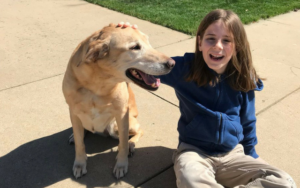
It doesn’t matter whether they’re big, small, fluffy, young, or old—Gideon Kidd loves dogs. The nine-year-old loves their different personalities and the way they roll over on their backs for belly rubs. He even loves it when they lick his face.
Gideon has one dog at home named Walter (along with three cats and two gerbils), but his love for furry friends extends to the entire canine kingdom. All he wants to do is pet dogs, and while he’s at it, he’s spreading an important message. Regardless of the kind of day you’re having, petting a dog (or seeing a picture of a kid petting a dog) will always make you smile.
I pet Tréan. He is 6 years old and a Great Pyrenees. He is very protective. His fur is soft and fluffy. Tréan likes to bark. Sometimes he likes to bark just to let the world know he is there. pic.twitter.com/sR5XkZORae
— I've Pet That Dog (@IvePetThatDog) May 19, 2018
As part of Gideon’s mission to pet as many dogs as possible, he started his own website. It’s called “I’ve Pet That Dog,” and every day, he posts a picture of a new dog he’s met. He includes a short description of his new friend, and so far, he’s featured over 300 dogs. His website is a big hit, and his mom recently got the idea that he’d reach even more people if he also had a Twitter. She helped Gideon create his account, and in only a few weeks, his audience has grown tremendously. He started with a few hundred fellow dog-loving followers, but after local interviews and media features, people from all over started hearing about the kid who loves to take pictures with dogs. He’s at 52,000 followers so far, and that number grows every day.
I pet Keisha and Zorro. They are Siberian huskies. They only want to eat human food and try their best to get some. They love to swim and play all day. pic.twitter.com/yduZkLwryd
— I've Pet That Dog (@IvePetThatDog) May 15, 2018
Gideon’s idea is simple; there’s no gimmick or special ploy. He’s not fundraising or trying to become famous, all he wants to do is show people how great dogs really are. Before he pets a dog, he always stops and asks the dog’s handler for permission. If they say yes, he extends his hand toward the dog to let them smell him first. If the dog seems comfortable, then Gideon goes in for the pets. He likes talking to people about their dogs’ personalities, and he learns a lot about different breeds.
I pet Sasha. She is an 11 year old golden lab mix. She came from a litter of only two puppies, which is rare. pic.twitter.com/tudL4odEQ0
— I've Pet That Dog (@IvePetThatDog) April 28, 2018
The fourth-grader pets big dogs and little dogs, and he’s always on the lookout for new dogs to meet. He told Today that he has already met all the dogs in his neighborhood, and now he and his mom drive around other places for the sole purpose of finding dogs to pet. When they see someone out walking their dog, they always pull over. Almost everyone they’ve met so far has been happy to help Gideon reach his goal of petting as many dogs as possible—and the dogs seem to like it too.
Gideon says he wants to pet one million dogs, and he’s willing to go the distance to make it happen. Gideon’s message is something everyone can relate to—when life gets rough, sometimes all you need to do is stop and pet a dog. Visit his website and follow him on Twitter for a daily dose of happiness.
h/t: Today
Featured image via Twitter/I’ve Pet That Dog
via Whisker Therapy
Can Dogs “Fake” Illnesses & Injuries For Attention?

First off: if your dog seems hurt or ill, he probably is. Canine instinct is to avoid showing signs of weakness, so take it seriously if something seems off.
With that said, there are some crafty canines who seem to put on a cough or limp in order to score extra love and attention from their humans.

The idea of dogs “faking” illnesses or injuries to gain attention is not only supported by countless pawrents, many veterinarians also back the concept. Dr. Richard Pitcairn author of Natural Health for Dogs and Cats, says it usually begins with a genuine symptom of pain or sickness. The response of the owner is what encourages the dog to continue the behavior after the issue has resolved:
“Say your dog is feeling lonely because you went back to work and just don’t have as much time for him as you used to. Before long, he develops a minor symptom – a cough – that worries you. Every time he coughs you rush over, pet him, and murmur comforting words… Pretty soon the dog gets the idea that every time he coughs he gets what he wants – your loving attention. What incentive is there for him to get well and stop coughing?”

Much like learning to sit or shake in exchange for a treat, the dog figures out that a minor symptom brings you running to his side, ready to shower him with affection. He then continues to sniffle after his cold has resolved or favor his paw after it has healed. Pretty clever, huh?
So, how can you tell if your pup has a real problem or just a flair for the dramatic? Luckily, dogs cannot mimic the majority of symptoms such as fevers, diarrhea or inflamed skin. Most faker-Fidos will limp, cough, sneeze, sniffle or itch – symptoms they can control.
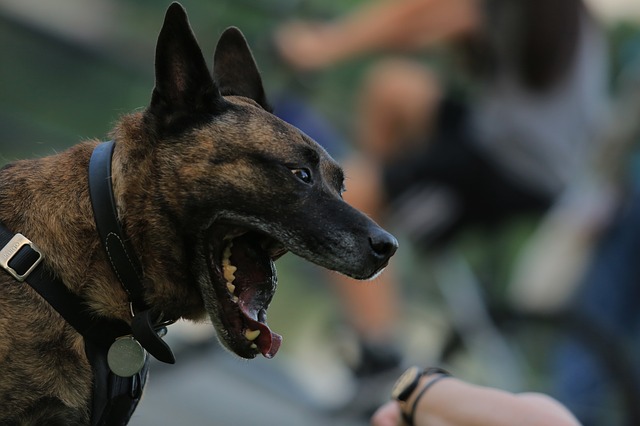
If your dog is showing any signs of illness or injury, give him the benefit of the doubt and see your vet. If he or she cannot find a clear medical explanation for the symptom(s), it does not necessarily mean your pooch is faking.
Dogs suffer pulled muscles, minor ailments and general aches and pains just like we do. Since they cannot describe how they are feeling, diagnosing an exact cause can be quite difficult.

Consider how you feel when you are recouperating from a twisted ankle or a bout of the flu. Just as you experience ups and downs along the road to recovery, so does your dog.
If there has been a recent injury or illness, your pup may suffer minor relapses before the issue is fully resolved. However, if your vet cannot find any sign of the previous ailment, you may have a faker on your hands!

See if you can entrap your cunning canine into revealing his ruse. Since most fakers do so to gain your sympathies, try briefly ignoring him to see if his symptoms magically reappear.
If it turns out your dog is putting on an act, consider what his motives might be. Have there been any major life changes lately? Longer hours at the office? A new relationship pulling away your attention?

Resolving your dog’s phantom illness or injury may be as simple as providing 20 minutes of your undivided attention each day. Whether it be a walk around the block, a game of fetch, or a simple cuddle session, focusing on your dog will show him that he is still a priority in your life.
H/T to WildInsights.com
via Whisker Therapy
Dry Nose Is A Common Issue With Many Boston Terriers, Here’s How You Can Make Life Easier On Them

You have likely heard that a wet nose equals a healthy dog. In reality, the canine nose alternates between wet and dry in response to a variety of factors. Problems arise when the nose becomes so dry that it cracks or flakes.
Overly dry noses are uncomfortable and can affect the way your dog experiences the world.

Scent is arguably a dog’s most important sense. It’s how they first recognize the ones they love and explore the environment around them. Alexandra Horowitz, author of Inside of a Dog: What Dogs See, Smell, and Know, goes so far as to say dogs “see with their noses.”
But in order for the incredible sensory apparatus within the canine nose to operate at full capacity, the external skin must be moist and spongy.
Brachycephalic dog breeds like Boston Terriers are especially prone to dry, cracked noses due to the anatomy of their heads. Their noses sit high on their stubby muzzles, making it difficult to reach them with their tongues.
Luckily, protecting your Boston Terrier from the discomfort and decreased sensory input of a dry nose can be achieved in two simple steps:
1. Pinpoint the Cause(s)
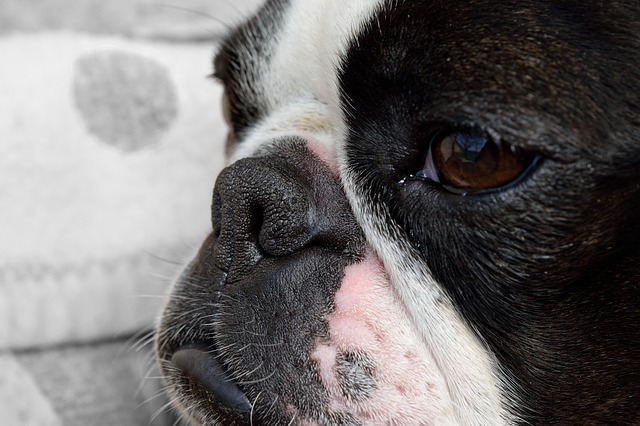
- Weather: You may notice that your dog’s nose is affected by extreme heat or cold, or that sun exposure contributes to its dryness. Indoor heating in the winter can also be a culprit.
- Allergies: Boston Terriers are often prone to seasonal, contact and food allergies. You may want to avoid plastic bowls and toys and consult with your vet about your dog’s particular sensitivities.
- Dehydration: Make sure your dog drinks plenty of fresh water, especially in hot, humid weather. If he or she is drinking or urinating excessively, see your vet to rule out diabetes or problems with the kidneys which can cause dehydration.
- Medical Conditions: There are several medical conditions that can contribute to a dog’s dry nose including neurological issues that cause excessive licking and autoimmune disorders. See your vet regularly and report any concerning symptoms. He or she may recommend lab work to rule out a serious problem.
2. Apply A Soothing Nose Balm
Barring any underlying medical condition, you can begin to heal your dog’s crusty nose with a soothing product like Nature’s Butter Nose Balm. Hand-mixed on a family farm in Minnesota, this cruelty-free balm is composed of a mixture of Shea Butter, Olive Oil, Almond Oil, Coconut Oil, Beeswax, Avocado Oil, Coca Seed Butter and Castor Oil.
The different oils and butters absorb into the skin at varying rates, ensuring maximum, long-lasting effects. First, the lighter oils soak in for fast results. Next, the medium weight oils add a deeper layer of moisture. And finally, the heavy-duty butters melt into your dog’s nose, bringing extra relief.
The ingredients in Nature’s Butter Snout Balm are non-toxic, so they won’t harm your pup if accidentally ingested. Best of all, this product, like all iHeartDogs merchandise, gives back to shelter dogs in need. Every tin of snout balm, provides five healthy meals to pups awaiting their forever families in shelters across the country.
Our customers have given Nature’s Butter Snout Balm a five star rating. Check out what they had to say:
Wonderful product, it really does work. In 4 days it smoothed my little guys nose. So happy that there’s a product that does what it said it would. This is staying on my great product list. Thank youVery excellent product & Dooley gives it a 4 paws up solute!! Thanks for your wonderful product!!
Love this and my dogs nose is softer and the cracks all healed!
Learn more and get yours here!
These statements have not been evaluated by the Food and Drug Administration. This product is not intended to diagnose, treat, cure, or prevent any disease. The information on this website is not intended to replace a one-on-one relationship with a qualified health care professional.
are professional. </em>
via Whisker Therapy
Dry Nose Is A Common Issue With Many French Bulldogs, Here’s How You Can Make Life Easier On Them

You have likely heard that a wet nose equals a healthy dog. In reality, the canine nose alternates between wet and dry in response to a variety of factors. Problems arise when the nose becomes so dry that it cracks or flakes.
Overly dry noses are uncomfortable and can affect the way your dog experiences the world.

Scent is arguably a dog’s most important sense. It’s how they first recognize the ones they love and explore the environment around them. Alexandra Horowitz, author of Inside of a Dog: What Dogs See, Smell, and Know, goes so far as to say dogs “see with their noses.”
But in order for the incredible sensory apparatus within the canine nose to operate at full capacity, the external skin must be moist and spongy.
Brachycephalic dog breeds like French Bulldogs are especially prone to dry, cracked noses due to the anatomy of their heads. Their noses sit high on their stubby muzzles, making it difficult to reach them with their tongues.
Luckily, protecting your Frenchie from the discomfort and decreased sensory input of a dry nose can be achieved in two simple steps:
1. Pinpoint the Cause(s)
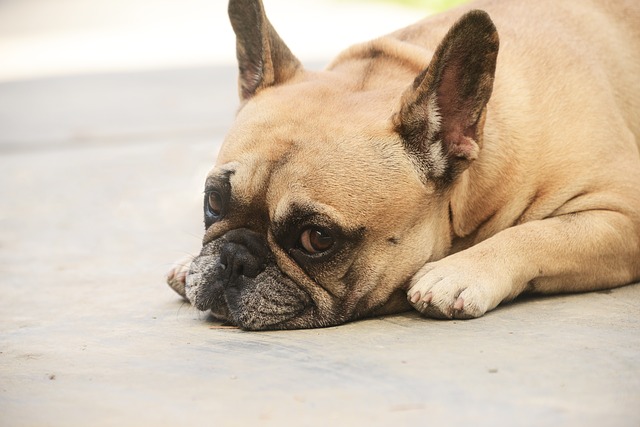
- Weather: You may notice that your dog’s nose is affected by extreme heat or cold, or that sun exposure contributes to its dryness. Indoor heating in the winter can also be a culprit.
- Allergies: French Bulldogs are often prone to seasonal, contact and food allergies. You may want to avoid plastic bowls and toys and consult with your vet about your dog’s particular sensitivities.
- Dehydration: Make sure your dog drinks plenty of fresh water, especially in hot, humid weather. If he or she is drinking or urinating excessively, see your vet to rule out diabetes or problems with the kidneys which can cause dehydration.
- Medical Conditions: There are several medical conditions that can contribute to a dog’s dry nose including neurological issues that cause excessive licking and autoimmune disorders. See your vet regularly and report any concerning symptoms. He or she may recommend lab work to rule out a serious problem.
2. Apply A Soothing Nose Balm
Barring any underlying medical condition, you can begin to heal your dog’s crusty nose with a soothing product like Nature’s Butter Nose Balm. Hand-mixed on a family farm in Minnesota, this cruelty-free balm is composed of a mixture of Shea Butter, Olive Oil, Almond Oil, Coconut Oil, Beeswax, Avocado Oil, Coca Seed Butter and Castor Oil.
The different oils and butters absorb into the skin at varying rates, ensuring maximum, long-lasting effects. First, the lighter oils soak in for fast results. Next, the medium weight oils add a deeper layer of moisture. And finally, the heavy-duty butters melt into your dog’s nose, bringing extra relief.
The ingredients in Nature’s Butter Snout Balm are non-toxic, so they won’t harm your pup if accidentally ingested. Best of all, this product, like all iHeartDogs merchandise, gives back to shelter dogs in need. Every tin of snout balm, provides five healthy meals to pups awaiting their forever families in shelters across the country.
Our customers have given Nature’s Butter Snout Balm a five star rating. Check out what they had to say:
Wonderful product, it really does work. In 4 days it smoothed my little guys nose. So happy that there’s a product that does what it said it would. This is staying on my great product list. Thank youVery excellent product & Dooley gives it a 4 paws up solute!! Thanks for your wonderful product!!
Love this and my dogs nose is softer and the cracks all healed!
Learn more and get yours here!
These statements have not been evaluated by the Food and Drug Administration. This product is not intended to diagnose, treat, cure, or prevent any disease. The information on this website is not intended to replace a one-on-one relationship with a qualified health care professional.
via Whisker Therapy
Dry Nose Is A Common Issue With Many Boxers, Here’s How You Can Make Life Easier On Them

You have likely heard that a wet nose equals a healthy dog. In reality, the canine nose alternates between wet and dry in response to a variety of factors. Problems arise when the nose becomes so dry that it cracks or flakes.
Overly dry noses are uncomfortable and can affect the way your dog experiences the world.

Scent is arguably a dog’s most important sense. It’s how they first recognize the ones they love and explore the environment around them. Alexandra Horowitz, author of Inside of a Dog: What Dogs See, Smell, and Know, goes so far as to say dogs “see with their noses.”
But in order for the incredible sensory apparatus within the canine nose to operate at full capacity, the external skin must be moist and spongy.
Brachycephalic dog breeds like Boxers are especially prone to dry, cracked noses due to the anatomy of their heads. Their noses sit high on their stubby muzzles, making it difficult to reach them with their tongues.
Luckily, protecting your Boxer from the discomfort and decreased sensory input of a dry nose can be achieved in two simple steps:
1. Pinpoint the Cause(s)

- Weather: You may notice that your dog’s nose is affected by extreme heat or cold, or that sun exposure contributes to its dryness. Indoor heating in the winter can also be a culprit.
- Allergies: Boxers are often prone to seasonal, contact and food allergies. You may want to avoid plastic bowls and toys and consult with your vet about your dog’s particular sensitivities.
- Dehydration: Make sure your dog drinks plenty of fresh water, especially in hot, humid weather. If he or she is drinking or urinating excessively, see your vet to rule out diabetes or problems with the kidneys which can cause dehydration.
- Medical Conditions: There are several medical conditions that can contribute to a dog’s dry nose including neurological issues that cause excessive licking and autoimmune disorders. See your vet regularly and report any concerning symptoms. He or she may recommend lab work to rule out a serious problem.
2. Apply A Soothing Nose Balm
Barring any underlying medical condition, you can begin to heal your dog’s crusty nose with a soothing product like Nature’s Butter Nose Balm. Hand-mixed on a family farm in Minnesota, this cruelty-free balm is composed of a mixture of Shea Butter, Olive Oil, Almond Oil, Coconut Oil, Beeswax, Avocado Oil, Coca Seed Butter and Castor Oil.
The different oils and butters absorb into the skin at varying rates, ensuring maximum, long-lasting effects. First, the lighter oils soak in for fast results. Next, the medium weight oils add a deeper layer of moisture. And finally, the heavy-duty butters melt into your dog’s nose, bringing extra relief.
The ingredients in Nature’s Butter Snout Balm are non-toxic, so they won’t harm your pup if accidentally ingested. Best of all, this product, like all iHeartDogs merchandise, gives back to shelter dogs in need. Every tin of snout balm, provides five healthy meals to pups awaiting their forever families in shelters across the country.
Our customers have given Nature’s Butter Snout Balm a five star rating. Check out what they had to say:
Wonderful product, it really does work. In 4 days it smoothed my little guys nose. So happy that there’s a product that does what it said it would. This is staying on my great product list. Thank youVery excellent product & Dooley gives it a 4 paws up solute!! Thanks for your wonderful product!!
Love this and my dogs nose is softer and the cracks all healed!
Learn more and get yours here!
These statements have not been evaluated by the Food and Drug Administration. This product is not intended to diagnose, treat, cure, or prevent any disease. The information on this website is not intended to replace a one-on-one relationship with a qualified health care professional.
via Whisker Therapy
Dry Nose Is A Common Issue With Many Pugs, Here’s How You Can Make Life Easier On Them

You have likely heard that a wet nose equals a healthy dog. In reality, the canine nose alternates between wet and dry in response to a variety of factors. Problems arise when the nose becomes so dry that it cracks or flakes.
Overly dry noses are uncomfortable and can affect the way your dog experiences the world.

Scent is arguably a dog’s most important sense. It’s how they first recognize the ones they love and explore the environment around them. Alexandra Horowitz, author of Inside of a Dog: What Dogs See, Smell, and Know, goes so far as to say dogs “see with their noses.”
But in order for the incredible sensory apparatus within the canine nose to operate at full capacity, the external skin must be moist and spongy.
Brachycephalic dog breeds like Pugs are especially prone to dry, cracked noses due to the anatomy of their heads. Their noses sit high on their stubby muzzles, making it difficult to reach them with their tongues.
Luckily, protecting your Pug from the discomfort and decreased sensory input of a dry nose can be achieved in two simple steps:
1. Pinpoint the Cause(s)

- Weather: You may notice that your dog’s nose is affected by extreme heat or cold, or that sun exposure contributes to its dryness. Indoor heating in the winter can also be a culprit.
- Allergies: Pugs are often prone to seasonal, contact and food allergies. You may want to avoid plastic bowls and toys and consult with your vet about your dog’s particular sensitivities.
- Dehydration: Make sure your dog drinks plenty of fresh water, especially in hot, humid weather. If he or she is drinking or urinating excessively, see your vet to rule out diabetes or problems with the kidneys which can cause dehydration.
- Medical Conditions: There are several medical conditions that can contribute to a dog’s dry nose including neurological issues that cause excessive licking and autoimmune disorders. See your vet regularly and report any concerning symptoms. He or she may recommend lab work to rule out a serious problem.
2. Apply A Soothing Nose Balm
Barring any underlying medical condition, you can begin to heal your dog’s crusty nose with a soothing product like Nature’s Butter Nose Balm. Hand-mixed on a family farm in Minnesota, this cruelty-free balm is composed of a mixture of Shea Butter, Olive Oil, Almond Oil, Coconut Oil, Beeswax, Avocado Oil, Coca Seed Butter and Castor Oil.
The different oils and butters absorb into the skin at varying rates, ensuring maximum, long-lasting effects. First, the lighter oils soak in for fast results. Next, the medium weight oils add a deeper layer of moisture. And finally, the heavy-duty butters melt into your dog’s nose, bringing extra relief.
The ingredients in Nature’s Butter Snout Balm are non-toxic, so they won’t harm your pup if accidentally ingested. Best of all, this product, like all iHeartDogs merchandise, gives back to shelter dogs in need. Every tin of snout balm, provides five healthy meals to pups awaiting their forever families in shelters across the country.
Our customers have given Nature’s Butter Snout Balm a five star rating. Check out what they had to say:
Wonderful product, it really does work. In 4 days it smoothed my little guys nose. So happy that there’s a product that does what it said it would. This is staying on my great product list. Thank youVery excellent product & Dooley gives it a 4 paws up solute!! Thanks for your wonderful product!!
Love this and my dogs nose is softer and the cracks all healed!
Learn more and get yours here!
These statements have not been evaluated by the Food and Drug Administration. This product is not intended to diagnose, treat, cure, or prevent any disease. The information on this website is not intended to replace a one-on-one relationship with a qualified health care professional.
via Whisker Therapy
Deterring Loose Dogs
Unfortunately, we seem to be in a time when very few dogs are receiving the socialization or training they need to be good companions and good canine citizens.
I see a lot of dogs that are reactive to a large majority of situations.
And, I see a lot of dogs that are severely dog aggressive.
Tips on Stopping a Loose Dog from Approaching You
Ironically, I had a horrible experience in my own yard just the other day.
My brother’s dogs were outside in the back yard. I was getting ready to go to the gym, but I knew my girl Fury needed to go out, so I let her out in our front yard.
She had her two front paws on our deck, and her two back paws in the grass, squatting to pee when I heard the neighbor dog growl, as he dug his nails into the cement of the driveway to come and attack my dog.
As he did so, I could hear the neighbor lady yelling about how he is really a friendly dog.
Luckily, 25+ years as a professional dog trainer and over 15 as a veterinary technician has given me some quick reflexes, and thankfully my dog was within arm’s length.
I grabbed her by her scruff (she is 60 pounds), opened the door, and threw her inside, simply by instinct.
He came at us so fast I had to shut him in my own front door to get him to back away.
It was terrifying!
And, although I thought I already knew a lot about deterring loose dogs, I learned even more from this experience.
Although I yelled at the owner to get the dog, and then at the dog, and stomped toward him, he was hell-bent on attacking my dog.
Had I not intervened so quickly and been able to get her inside, there would have been a horrible dog fight.
Even after shutting him out for a few moments, when I went to exit the front door he was still there trying to get inside.
He literally would have come into my house and attacked my dog!
He could have killed my dog.
It was at that moment that I decided to always be prepared.
I would do anything for my dog.
I would have even been willing to commit violence on her behalf.
Be Prepared
I have become nervous about walking my dogs in neighborhoods.
But I never thought I had to fear for them in my yard, or that a dog would come into my house.
My first line of defense has always been to put my dogs in a “down stay” so that I can stomp at and yell at the charging dog, as well as yelling for the owner.

Yes, I would have pepper sprayed them both if I had to; it is better than having a dead dog.
I will also be walking with a weapon.
I hate to say it, but I would use one if I had to, to save my dog’s life.
You must be mentally prepared to deal with the situation.
I will also never leave without carrying my phone. I have often been on walks around the neighborhood without my phone.
I realize I may need it to call the police.
The Best Defense?
Beyond all that, which is critically important, what is THE best defense?
Well behaved dogs.
If my dog had been at all dog aggressive or reactive, or if I hadn’t been able to control her, I would have lost the war.
The fact that my dog listened and respected me is a key piece in saving her life that day.
I can try to control or deter the other dog, but the truth is that the only dog I have control over is my own.
And, two dogs that are dog aggressive or dog reactive are going to have a much, much worse fight!
Keep your dog on a leash and near you.
If your dog is off leash and far away from you, you have no control.
Leashes are a blessing.
Leashes keep dogs safe.
Leashes save lives.
If there is an altercation, you don’t want to have the dog that was off leash, because being off leash in most places is illegal.
It is sad to admit, but we live in a different world than we did just 15 years ago.
You must prepare to deal with the dogs of today and the problems they have, and not be in denial.
Behavior gives us a lot of information (despite what owners say). Use that information to prepare yourself!
via Whisker Therapy
These 12 Dog Breeds Are The Worst Swimmers

All dogs have their strengths and weaknesses. While some pups glide through the water as gracefully and effortlessly as Michael Phelps, others flounder (pun definitely intended).
The breeds on this list may still be able to enjoy the water, but they should definitely do so while wearing a life vest!
1. Basset Hound
These sad-looking hounds have large heads, dense bone structure, long, thick torsos and disproportionately short legs, making swimming very difficult. In addition to their non-buoyant bodies, Bassets also have long, floppy ears that trap water and provide the perfect environment for infection-causing yeast and bacteria.
While they love to play and can be quite agile on dry land, Basset Hounds simply aren’t built for water sports!
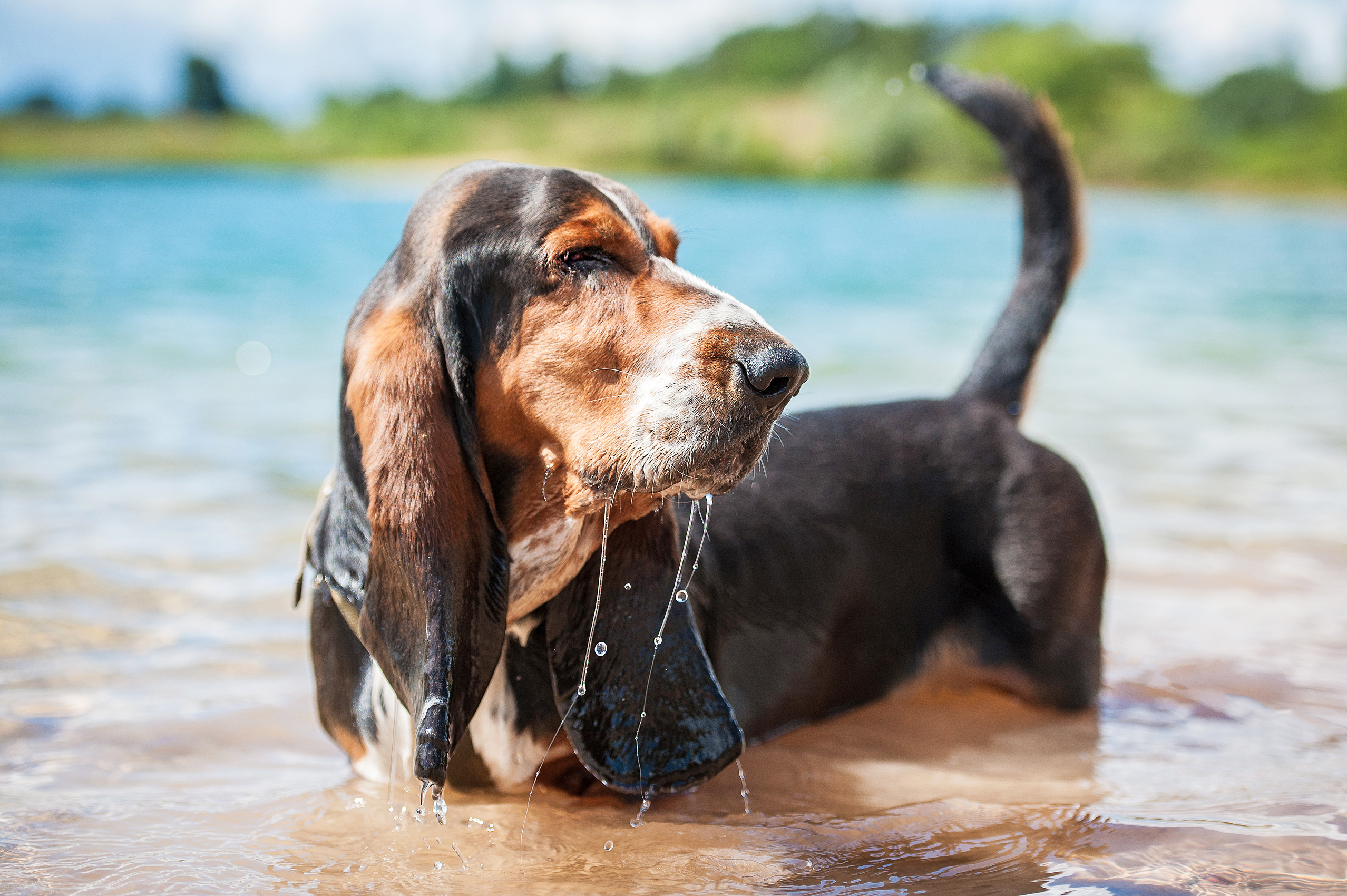
2. Bulldog
Don’t let all those videos of surfing Bulldogs fool you! These guys have excellent balance, but their huge heads, deep chests, dense bodies, and short legs make it difficult to stay afloat unaided. In addition, Bulldogs are brachycephalic, and prone to breathing difficulties – especially during exercise. Hot weather, overexertion and water inhalation can all cause major problems for these short-nosed pups.
If you would like your Bulldog to join you at the beach or by the pool, make sure he wears a life vest and is monitored closely for signs of distress.
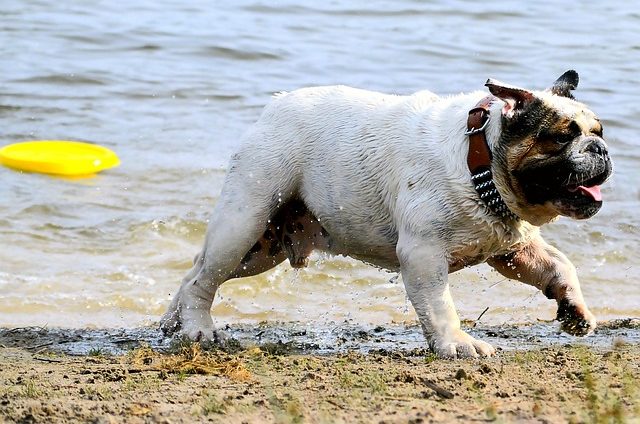
3. French Bulldog
Frenchies have all the same physical limitations of their English Bulldog cousins, albeit to a lesser extent. Although they are slightly better equipped for the doggy paddle, they too should be closely monitored and have access to a flotation device.
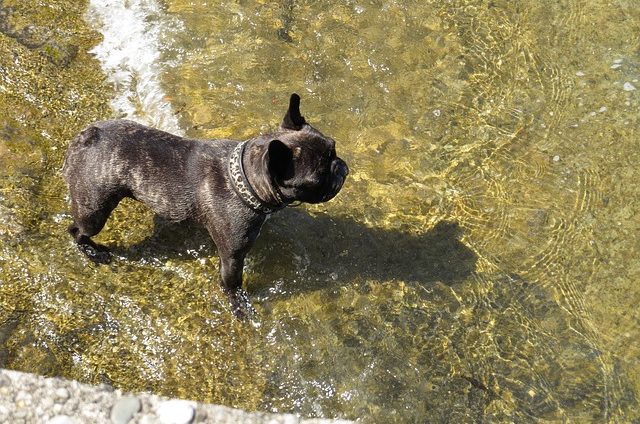
4. Pug
Built like a tiny Bulldog, the Pug has all the same body traits, which means he is not built for swimming either. Another brachycephalic breed, the Pug has a short snout, narrow nostrils and an elongated soft palate that can block the airway during exercise or excitement.
These respiratory problems make swimming difficult, but Pugs and other brachycephalic breeds face yet another challenge in the water. Because their faces are flat, they must tilt their heads far back to ensure their noses and mouths stay above the water line. This causes their body to become vertical rather than horizontal, meaning they must paddle even harder to keep from sinking.
If your Pug will be joining you poolside, a life vest is a must!
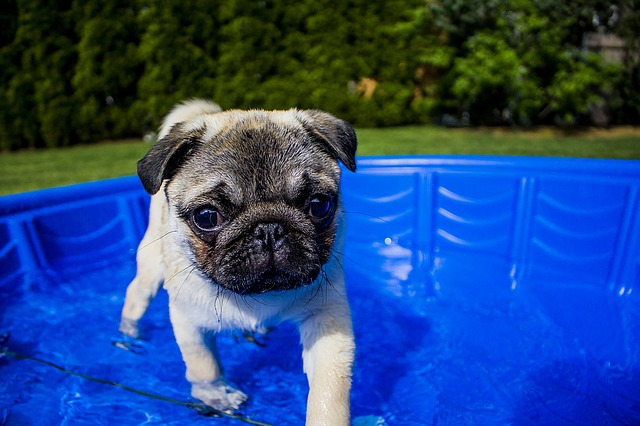
5. Daschund
These sassy little hot-dogs are remarkable athletes on land, but their skills do not transfer to the water. Doxies are relatively lightweight with longer muzzles, so they do not face the respiratory issues that affect Brachycephalic breeds.
However, their long bodies and short legs mean that Dachshunds must work extremely hard and exhaust quite quickly when swimming. This poor endurance combined with their short stature makes drowning a very real risk – even in shallow water.
Since Doxies love to run and jump, why not try a yard sprinkler to keep your hot-dog safe, cool and happy this summer?
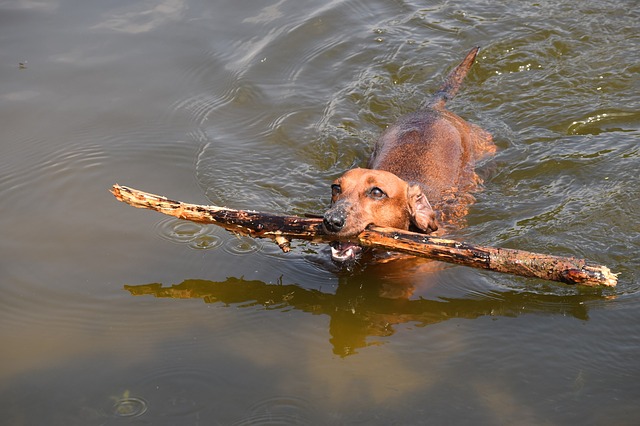
6. Pekingese
This poor little pooch has a flat, brachycephalic facial structure and short legs, making unaided swimming extremely risky. In addition, Pekingese are not particularly strong, muscular or athletic and tire quickly during exercise.
Should you decide to bring your Peke along for a day at the beach or pool, be hyper-vigilant! Provide plenty of shade and fresh drinking water to stave off heat stroke, monitor him closely to prevent over-exertion or falls into the deep end, and of course, fit your pooch with a life vest!

7. Boxer
With their long legs and powerfully muscled bodies, Boxers may look like natural born swimmers, but they are predisposed to many of the same respiratory problems as their smaller, flat-faced cousins. This breed is considered brachycephalic, so they may struggle to keep their noses and mouths above water or face respiratory distress and over-exertion if left to swim for too long.
The good news is, Boxers love to run and splash in the shallows, so a kiddie pool, a sprinkler or a game of fetch along the shore should keep them happy!

8. Pembroke Welsh Corgi
Corgis may be short and stout, but they are also very athletic and powerful – on land, that is! Originally bred to herd sheep and cattle, these confident little dogs may think they have what it takes to stay afloat. However, their dense, barrel-shaped bodies and short legs are just not cut out for water sports.
Your Corgi can still enjoy splashing in the shallows, wading in a kiddie pool, or sniffing the sea air from the safety of your boat – while wearing a life vest, of course!

9. Bull Terrier
The athletic, fun-loving Bull Terrier is up for anything! Unfortunately his dense, solidly muscled body paired with his short legs can make swimming a challenge.
In addition, the Bull Terrier has a large, heavy head that tends to be disproportionate to his body, making it difficult to hold above water as he paddles.
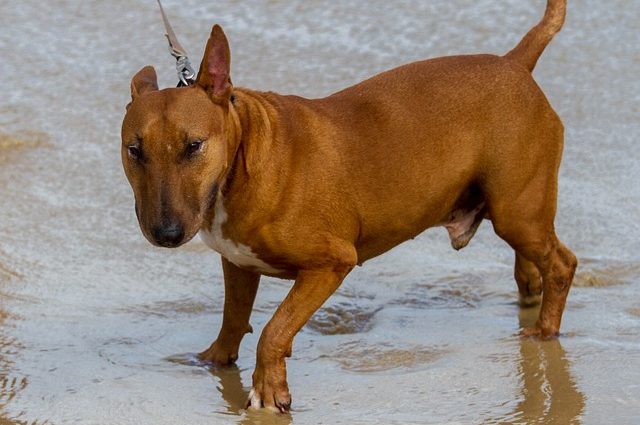
10. Shih Tzu
Not only are Shih Tzus short-legged and flat-faced, they also have thick, dense coats that can weigh them down in the water or cover their face, making breathing harder. Since they are not cut out for swimming, these little dogs may panic in the water, increasing their risk of drowning.
Do not force your Shih Tzu to join you in the pool, but if he or she is interested, be sure to use a life vest and watch closely for signs of distress.
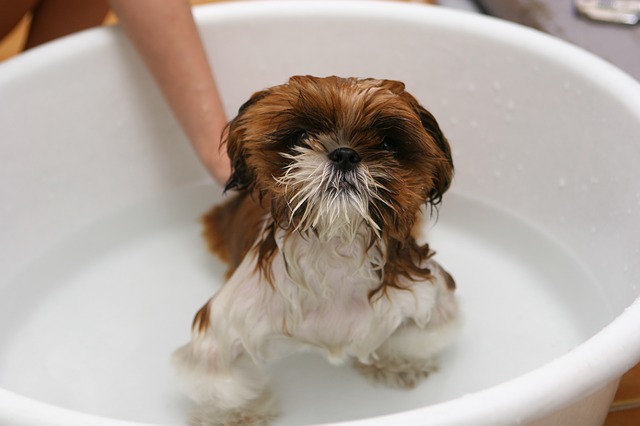
11. Chow Chow
The poor Chow has just about every challenging feature on this list! With his thick, dense coat, deep chest, short legs and flattened muzzle, the Chow is prone to over-exertion, respiratory distress and water-logging.
Add in their notoriously stubborn nature and you have a potential seaside disaster!
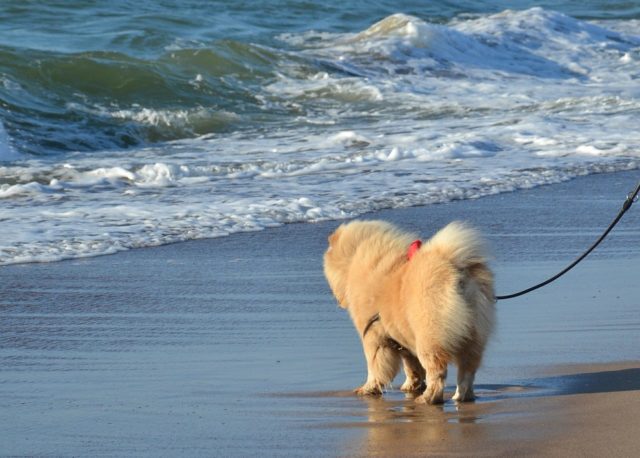
12. Shar Pei
Shar Peis have shorter muzzles, narrowed nostrils and may even suffer from Brachycephalic Airway Syndrome. In addition to their potentially serious respiratory problems, their wrinkly skin and short, tight ears trap moisture and are notoriously prone to infections. Romping in the sand is a much safer choice for these pups!

If you do not see your dog’s breed on this list, it does not necessarily mean swimming is safe for them. There are several water-related hazards that can affect even the most buoyant pups. Large waves, powerful currents, aquatic creatures, hot sand, sharp shells and pool chemicals can all pose a threat. There is also the risk of water intoxication, heat stroke and sheer exhaustion.
Senior dogs and those with physical limitations or disabilities are especially susceptible to water emergencies. Plan carefully before including your pooch in your pool or beachside activities!
Featured Image via Flickr/nikoretro
via Whisker Therapy
